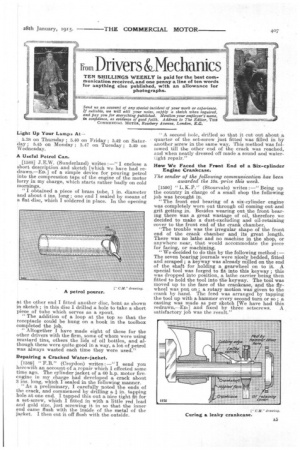[1588] J.E.W. (Sunderland) writes :—" I enclose a short description
Page 19

If you've noticed an error in this article please click here to report it so we can fix it.
and sketch [which we have had redrawn.—En] of a simple device for pouring petrol into the compression taps of the engine of the motor lorry in my charge, which starts rather badly on cold mornings.
"I obtained a piece of brass tube, 1 in. diameter and about 4 ins. long ; one end I sealed by means of a flat disc, which I soldered in place. In the opening at the other end I fitted another disc, bent as shown in sketch ; in this disc I drilled a hole to take a short piece of tube which serves as a spout. "The addition of a loop at the top so that the receptacle could be hung on a hook in the toolbox completed the job. "Altogether I have made eight of these for the other drivers with the firm, some of whom were using mustard tins, others the lids of oil bottles, and although these were quite good in a way, a lot of petrol was always wasted each time they were used."
Repairing a Cracked Water-jacket.
[1589] " F.B." (Croydon) writes :—" I send you herewith an account of a repair which I effected some time ago. The cylinder jacket of a 60 h.p. motor fireengine in my charge had developed a. crack about 3 ins, long, which I sealed in the following manner. "As a preliminary, I carefully noted the ends of the crack, and commenced by drilling a I in. tapping hole at one end. I tapped this out a nice tight fit for a set-screw, which I fitted in with a little red lead and gold size, just screwing it in so that the inner end came flush with the inside of the metal of the japket. I then cut it off flush with the outside. " A second hole, drilled so that it cut out about quarter of the set-screw just fitted was filled in by another screw in the same way. This method was followed till the other end of the crack was reached, and when neatly dressed off made a sound and watertight repair."
How We Faced the Front End of a Six-cylinder Engine Crankcase.
The sender of the following communication has been awarded the 10s. prize this week.
[1590] " L. K. (Stourvale) writes :—" Being up the country in charge of a small shop the following job was brought in. "The front end bearing of a six-cylinder engine was completely worn out through oil coming out and grit getting in. Besides wearing out the front bearing there was a great wastage of oil, therefore we decided to make a dust-excluding and oil-retaining cover to the front end of the crank chamber.
"The trouble was the irregular shape of the front end of the crank chamber and its great length. There was no lathe and no raaehine in the shop, or anywhere near, that would accommodate the piece for facing, or machining. "We decided to do this by the following method :— The seven bearing journals were nicely bedded, fitted
and scraped' a keyway was already milled on the end
of the shaft for holding a gearwheel on to it. A special tool was forged to fit into this keyway ; this was dropped into position, a lathe carrier being then fitted to hold the tool into the keyway. The tool was moved up to the face of the crankcase, and the fly wheel was put on ; a rotary motion was given to the crank by hand. The feed was arranged by tapping the tool up with a hammer every second turn or so ; a casting was made as per sketch [We have had this redrawn,--End and fixed by three setscrews. A satisfactory job was the result."




















